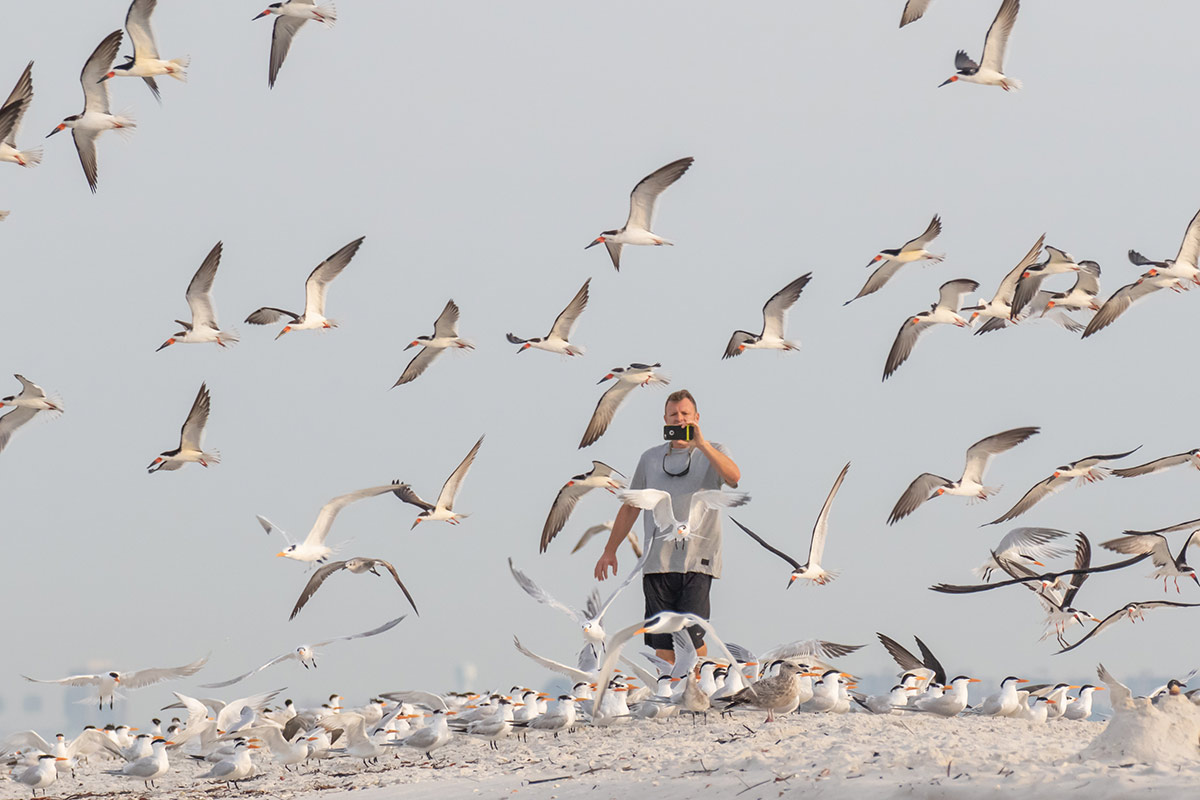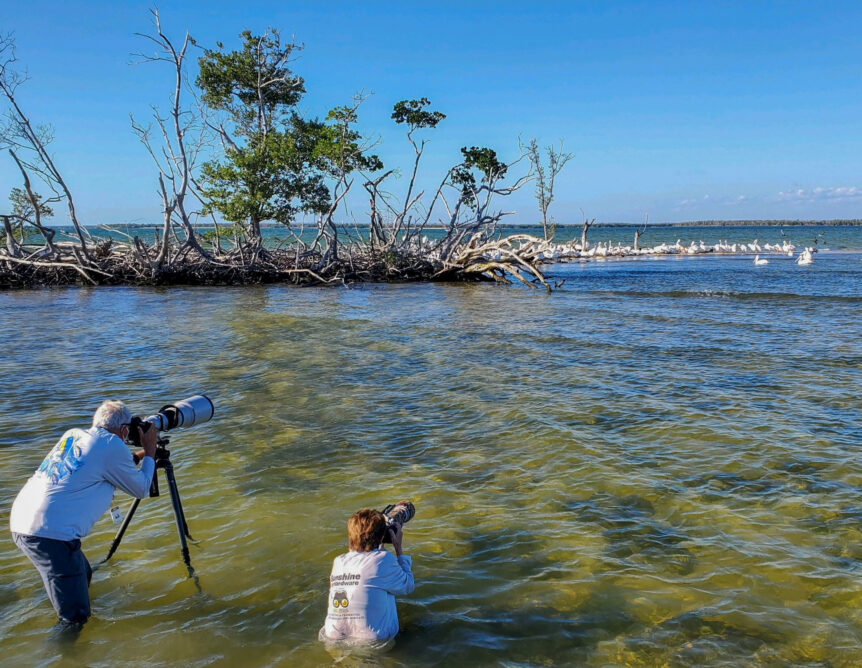Getting a Great Shot – Tips from Professional Photographers and Wildlife Biologists
All along the Atlantic coast, people love going to the beach to photograph birds. It can be exciting to find and photograph an endangered species like the Piping Plover or Red Knot, especially when they have adorable chicks to care for. But getting that perfect shot can cause beach birds and other wildlife serious harm. For them, the beach is their home – a place to feed, rest, and raise their young. It is important for photographers to understand the cues birds are giving, so you can give them the space they need to survive.
The health and safety of our subjects should always come first. Beach birds and other wildlife have ways of letting us know when they are being disturbed. Learn what cues to look for and check out the tips and tricks provided below so you can get that great shot without disturbing wildlife.
Before You Hit the Beach:
- Know the behavior of your subject! Learn to recognize when they are alert and nervous. Visit these sites to learn about behavior, ID tips, and their calls: https://www.allaboutbirds.org/news/ and https://merlin.allaboutbirds.org/
- Prepare for the day and pack your patience, along with your camera/binoculars in order to resist the temptation to creep too close to your subject.
- Review the section below on common signs of disturbance!
- Check the tides – bird behavior is often influenced by what is happening tidally. https://tidesandcurrents.noaa.gov/
When You Get to the Beach:
- Know and respect the rules of the site you are at. Always.
- If you notice the animal noticing you, back off. You are disturbing its natural behavior.
- Respect roped off areas or beaches that are closed to visitors.
- Human smells and food attract predators – be mindful and reduce the use of scents and don’t leave food out.
- Always give birds a minimum distance of 25 yards (some birds might need more!) which is the equivalent to two school buses. Using a long lens is a great way to ensure you are keeping enough space between you and your subject.
- Situate yourself in a place that is not in a direct line from where they are nesting to the water line. They need quick access to food!
- Never intentionally force birds to fly. If you are patient and wait long enough, you will likely see them naturally flush.
- Take EXTRA care if you see chicks: their parents are nearby and if you frighten them, they may stop feeding chicks, abandon them or leave them vulnerable to predators or extreme temperatures.
- Don’t follow the crowd. If you see a large group of photographers going after the same subject, politely ask the group to break up, or at least move on to something else.
- Never bait animals with audio calls, food, or scent.
- Do not use drones to photograph beach birds – they will react to drones taking off as though it is a predator by leaving their nest.
When You Post Your Photos Online:
- Note that you used a telephoto lens when you post images.
- To help reduce chronic disturbance, keep the site location to yourself, especially if the species is endangered, threatened, or rare.
- Lead by example – when you post pictures, share details in the caption about how you respected the birds’ space and make sure to add a caption about how your viewers can respect the wildlife you are sharing.
- Avoid posting photos of birds flushing away from the camera – although it can be pretty, most times these scenes are created by flushing birds, and posting photos of it encourages that behavior.
Common Signs of Disturbance
Each species has a distinct way to let you know when you have gotten too close. It’s important to research your subject before you head out. Here are some common signs to look for to keep your subject matter safe while you get a great shot. Whenever you are at the beach, remember, you are not alone. Thousands of people visit beaches along the coast each day. While it’s easy to think you are just one person who won’t have a big impact, the accumulative effect of chronic disturbance can easily lead to the death by a thousand wounds.

Never intentionally force birds to fly. If you are patient and wait long enough, you will likely see them naturally flush.
Nesting: During the nesting season (depends on where you are- Southeastern US is usually March-August), if there are birds above the high tide line in the dry sand, they are likely nesting or migrating. Some birds, like American Oystercatcher, Piping and Wilson’s Plovers are territorial shorebirds and defend their space by calling and performing displays. Other birds, like seabirds including terns and gulls, nest in colonies. These dense neighborhoods, where they rely on protection from threats by nesting in a large group, are often noisy and busy. In both cases, if birds feel threatened, they will leave their nests to perform displays or try to distract you from the area they are nesting. This can leave eggs and young chicks vulnerable to overheating in the sun, or vulnerable to predators who may be close by just waiting for a nest or chick to be left alone. This also means adults will not be spending their time feeding young chicks, which can, in some cases, be fatal.
Feeding: Shorebirds depend on tides for access to food and only have a narrow window of time to access food. If they can’t be where the food is, they might need to wait a whole tide cycle before they can access that resource again. When the tide is low, birds often feed in groups at the water’s edge. When birds are disturbed from their feeding activity they are forced to move using precious energy to find a new spot to feed.
Roosting: Resting flocks of birds are “roosting”, often digesting their food and storing energy that can help them survive cold periods during the winter, or complete marathon flights during migration. It’s important to recognize the signs of disturbing roosting birds. If you see them waking up, stretching their wings, moving off from the roosting area, and taking flight, give them more space. Disturbing birds during this time wastes valuable energy that could be the difference between surviving the winter, or successfully migrating.
Available Online Resources
- Ethical Field Practices from NA Nature Photography Association
- Wildlife Photography Techniques: An Ethical Guide to Taking Nature Pictures (format.com)
- Audubon’s Guide to Ethical Bird Photography and Videography | Audubon
- Pro tips for photographing shorebirds
- POL-Ethical-Birding-Guidelines.pdf (birdlife.org.au)
- Audubon’s ethical guide to bird photography
- How to be Shorebird Friendly Photographer
- How to Read the Tides for Shorebird Photography
- ABA Code of Birding Ethics – American Birding Association
- Information on why using drones is dangerous to birds and not worth it
- A Guide to Ethical Wildlife Photography – Wild Zambezi
- Wildlife Photography Ethics | Audubon Florida
- How to Respectfully Photograph and Observe Owls
- Cómo disminuir los impactos a las aves cuando las observamos o fotografiamos por la bióloga
- La fotografía de aves silvestres como herramienta de conservación por el fotógrafo

